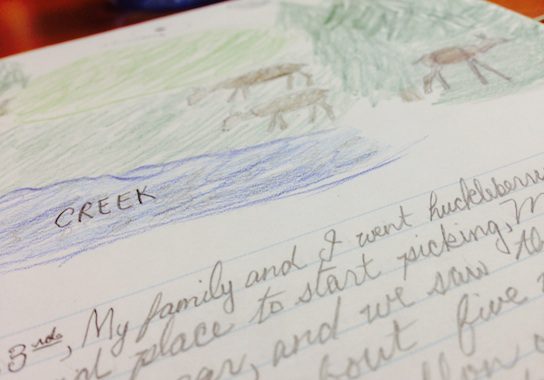Meeting Past Selves by Reading Where You’re From

After perusing some old bookshelves and boxes, I discovered an old nature diary. These excerpts were written by my 11-year old self:
On Monday, July 23, my family and I went huckleberry picking in the forest. As we were looking for a good place to start picking, Mom cried, “Look at the baby deer!” Dad stopped the car, and we saw a doe dash behind a bush. The baby deer stayed for about five minutes, and then disappeared.
After picking at least a gallon of huckleberrys [sic], we went back to where we had had a picnic, and washed our hands in the creek. Then we looked for rocks, and I found a piece of petrified wood.
On the way home, Katie looked for more deer, and soon called out, “A buck! A buck!” Dad turned around the car, and we saw the buck run away! After continuing our drive Katie called, “A doe! A doe!” I barely saw her, and I didn’t have enough room to draw her, and so I didn’t include her.
This bed is all a-bloom. I investigated it thouroughly [sic] and not a flower does not have intricate purples, blues, whites, pinks, and vivid strawberry. This bed also, is filled with frilly purple, triumphant yellow, soft strawberry pink, luscious green, and a few hints of snowy white.
I must say spring has come swiftly and sufficiently. When I enter the house, it looks so dark and gloomy compared to the fresh, yellow-white sunlight that streams through branches outside.
It is terrible writing. But it’s also interesting. I see a little girl who loved the outdoors, and loved beauty—and she was trying, desperately, to capture these moments before they faded away. I didn’t want to forget the first time I saw a piece of petrified wood or baby deer. I wanted to capture the beauty of a garden rose. The words are an interesting juxtaposition of almost terse journalistic chronicling, and an exaggerated romantic style.
I didn’t know it then, but I was writing to an audience of selves. Years pass, and a new self visits the journal—someone with greater experience, skepticism, knowledge. This new person reads with fresh eyes and perhaps amusement—but aloof as they may seem, they still feel kinship with the writer of the past.
This is the horror and wonder of writing: we know we will return to ourselves, five or 10 years down the road, and see a face we’ve forgotten. We will look closely at a soul whose face we know, but whose expression and turn of phrase is now old-fashioned (and sometimes cringe-worthy) to our eyes.
There are two ways to “read where you’re from,” and I think both are valuable exercises. The first is to revisit old diary entries, scribbles, photographs, and personal collections, such as the above. Not everyone is a writer, but almost every child collects memories from their childhood in one form or another. Revisiting such materials gives us a window into who we were, and the ways we’ve grown—or stayed the same. Revisiting old notebooks and diaries from childhood requires a sense of humor, perspective, and candor—to see oneself clearly, then and now.
The second way to “read where you’re from” is to revisit the things you read as a child, and to see how your perspective and insights have changed with time. A recent post at First Things explored the theological underpinnings of George MacDonald’s The Light Princess—and I was frankly astonished. When I read the book as a child, I saw nothing but a pleasant (and slightly strange) fairy tale. Reading the First Things piece encouraged me to go back and read it again—along with MacDonald’s other works that I loved in childhood, The Princess and the Goblin and Phantastes. It’s a treasure hunt—into MacDonald, and into my past.
This can also be a lovely exercise with one’s significant other—in A Severe Mercy, Sheldon Vanauken shares stories from his marriage to his wife, Jean (known as “Davy”). The two read all of each other’s favorite books, from childhood upwards. My husband and I have done this a few times—during a visit to a bookstore, he handed me Madeleine L’Engle’s A Wrinkle in Time, and I gave him Marguerite de Angeli’s The Door in the Wall. We sat together, delving further into each other’s childhood selves. Recently, we read Laddie and The Phantom Tollbooth aloud.
It’s a process of discovering the self and the “other,” our histories and our hidden treasure trove of memories. We can seek out gold we’ve forgotten or missed, delve into humor and joys still unseen. Regardless of what we find, it’s an adventure.
Comments